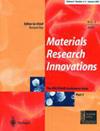A Simulation Study of n-ZnO/Perovskite/p-Cu2SnS3 Based Self-Powered Photodetector: Design and optimisation
Q2 Engineering
引用次数: 0
Abstract
ABSTRACT Perovskite has been widely used in the field of optoelectronics owing to its superb optoelectronic properties. The simplest fabrication along with low-temperature handling of perovskite-based planner structures (p-i-n or n-i-p) has drawn their potential impact in organic–inorganic lead halide optoelectronic devices. The poor conductivity, stability, and high processing cost of absorber materials hinder the optical performance of the device. The sandwiching of the perovskite as absorber materials between two inorganic materials working as electron transport layer (ETL) and hole transport layer (HTL) may be a possible solution. An active absorber perovskite (CH3NH3PbI3) assisted by two n-ZnO and p-CTS materials working as an ETL and HTL, respectively, has been used to maximize the overall performance of the proposed device. The resultant optimized device shows the maximum responsivity of ∼0.35 (A/W) for a broad visible spectrum (300–900 nm), while the EQE (%) reported in the range of 25–80%.基于n-ZnO/钙钛矿/p-Cu2SnS3自供电光电探测器的模拟研究:设计与优化
钙钛矿以其优异的光电性能在光电子领域得到了广泛的应用。最简单的制造以及钙钛矿基规划器结构(p-i-n或n-i-p)的低温处理已经在有机-无机卤化铅光电器件中引起了潜在的影响。吸收材料导电性差、稳定性差、加工成本高,影响了器件的光学性能。将钙钛矿作为吸收材料夹在作为电子传输层(ETL)和空穴传输层(HTL)的两种无机材料之间可能是一种解决方案。一种活性吸收剂钙钛矿(CH3NH3PbI3)在两种n-ZnO和p-CTS材料的辅助下分别作为ETL和HTL,以最大限度地提高所提出器件的整体性能。所得优化器件在宽可见光谱(300-900 nm)下的最大响应度为~ 0.35 (A/W),而EQE(%)在25-80%的范围内。
本文章由计算机程序翻译,如有差异,请以英文原文为准。
求助全文
约1分钟内获得全文
求助全文
来源期刊

Materials Research Innovations
工程技术-材料科学:综合
CiteScore
5.20
自引率
0.00%
发文量
38
审稿时长
2.8 months
期刊介绍:
Materials Research Innovations covers all areas of materials research with a particular interest in synthesis, processing, and properties from the nanoscale to the microscale to the bulk. Coverage includes all classes of material – ceramics, metals, and polymers; semiconductors and other functional materials; organic and inorganic materials – alone or in combination as composites. Innovation in composition and processing to impart special properties to bulk materials and coatings, and for innovative applications in technology, represents a strong focus. The journal attempts to balance enduring themes of science and engineering with the innovation provided by such areas of research activity.
 求助内容:
求助内容: 应助结果提醒方式:
应助结果提醒方式:


